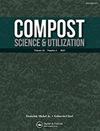Soluble Salts in Compost and Their Effects on Soil and Plants: A Review
IF 0.9
4区 农林科学
Q3 ECOLOGY
引用次数: 63
Abstract
Abstract The chemical, physical, and biological conditions of soil and growing media can be substantively improved by the addition of compost. Compost contains many plant essential nutrients (e.g. N, P, and K) and can also be a source of organic matter. However, concerns persist over composts with a high concentration of soluble salts and their effects on soil fertility, plant growth, and yields. Soluble salts refer to soluble ions such as Ca2+, K+, Mg2+, and Na+ in compost and are measured indirectly and cumulatively through electrical conductivity (EC). Specifically, compost salinity is commonly measured using a method referred to as EC5 whereas soils are measured using an ECe. The use of a variety of non-standardized methodologies often make interpreting results between studies difficult. A compost with an EC5 >5 dS m−1 could be the result of high concentrations of Na+ or other ions, which can be detrimental to plants due to their ability to accumulate in plant tissue and interfere with root uptake of water. Thus, reducing soluble salts, specifically Na+ and Cl− in composts is of high importance. Other soluble salts present in compost (e.g. K+ and Ca2+) are mineral nutrients required for plant growth and can aid in reducing soil sodicity. In appropriate proportions, quality compost with a high EC5 mixed with soil or media can enhance plant growth and yields. Composts with a high EC5 are adept at aiding in soil remediation by facilitating soil particle flocculation, helping leach Na+ deeper into the soil profile and raising soil cation exchange capacity in support of increased soil fertility. Labeling composts and developing appropriate application methods could allay concerns associated with composts where EC5 > 5 dS m−1and promote compost use and sustainable farming practices.堆肥中的可溶性盐及其对土壤和植物的影响
摘要添加堆肥可以显著改善土壤和生长介质的化学、物理和生物条件。堆肥含有许多植物必需营养素(如N、P和K),也是有机物的来源。然而,人们仍然担心含有高浓度可溶性盐的堆肥及其对土壤肥力、植物生长和产量的影响。可溶性盐是指堆肥中的可溶性离子,如Ca2+、K+、Mg2+和Na+,通过电导率(EC)间接和累积测量。具体而言,堆肥盐度通常使用称为EC5的方法进行测量,而土壤则使用ECe进行测量。各种非标准化方法的使用往往使研究之间的结果解释变得困难。EC5>5dS m−1的堆肥可能是高浓度Na+或其他离子的结果,这可能对植物有害,因为它们能够在植物组织中积累并干扰根系吸收水分。因此,减少堆肥中的可溶性盐,特别是Na+和Cl−是非常重要的。堆肥中存在的其他可溶性盐(如K+和Ca2+)是植物生长所需的矿物质营养素,有助于降低土壤碱度。在适当的比例下,高EC5的优质堆肥与土壤或培养基混合可以提高植物的生长和产量。具有高EC5的堆肥擅长于通过促进土壤颗粒絮凝、帮助Na+更深地渗入土壤剖面和提高土壤阳离子交换能力来帮助土壤修复,以支持提高土壤肥力。标记堆肥并制定适当的施用方法可以减轻与EC5>5dS m−1的堆肥相关的担忧,促进堆肥的使用和可持续农业实践。
本文章由计算机程序翻译,如有差异,请以英文原文为准。
求助全文
约1分钟内获得全文
求助全文
来源期刊

Compost Science & Utilization
农林科学-生态学
CiteScore
4.10
自引率
0.00%
发文量
0
审稿时长
>36 weeks
期刊介绍:
4 issues per year
Compost Science & Utilization is currently abstracted/indexed in: CABI Agriculture & Environment Abstracts, CSA Biotechnology and Environmental Engineering Abstracts, EBSCOhost Abstracts, Elsevier Compendex and GEOBASE Abstracts, PubMed, ProQuest Science Abstracts, and Thomson Reuters Biological Abstracts and Science Citation Index
 求助内容:
求助内容: 应助结果提醒方式:
应助结果提醒方式:


